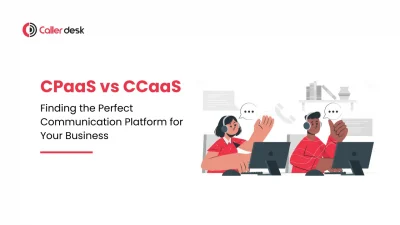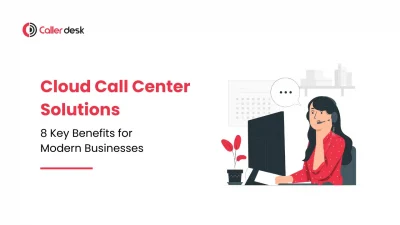Are you struggling to decide between a cloud-based call center and an on-premise call center for your business? This choice is crucial for enhancing your communication infrastructure, and it’s important to understand the unique benefits and potential challenges each option presents.
This blog will walk you through the key factors to consider, helping you determine which solution aligns best with your specific business needs.
What is On-Premise and Cloud Call Center?
An on-premise call center uses hardware and software that is installed and maintained on the company’s premises. It requires significant upfront investment but offers more control over operations. While a cloud call center operates through internet-based technology. It offers flexibility and scalability, allowing agents to work from various locations as long as they have an internet connection.
Differences Between Cloud and On-Premise Call Centers
1. Cost
Cloud Call Centers:
- Lower Initial Costs: There is no need for significant hardware investments.
- Subscription-Based: Pay-as-you-go pricing models make budgeting easier.
On-Premise Call Centers:
- High Initial Costs: Significant investment in infrastructure.
- Maintenance Costs: Ongoing costs for upgrades and repairs.
2. Scalability
Cloud Call Centers:
- Highly Scalable: Easily adjust the number of agents and features based on demand.
- Quick Deployment: Can be set up and expanded rapidly.
On-Premise Call Centers:
- Limited Scalability: Scaling requires additional hardware and software, which can be time-consuming.
- Longer Deployment Times: Expanding infrastructure can take weeks or months.
3. Flexibility
Cloud Call Centers:
- Remote Access: Agents can work from anywhere with an internet connection.
- Global Reach: Easier to support a global workforce.
On-Premise Call Centers:
- Location Bound: Typically requires agents to be on-site.
- Limited Remote Capabilities: More complex and costly to enable remote work.
4. Reliability
Cloud Call Centers:
- High Reliability: Providers often offer SLAs with uptime guarantees.
- Redundancy: Built-in failover systems ensure continuous operation.
On-Premise Call Centers:
- Direct Control: Full control over the infrastructure can mean quicker responses to issues.
- Single Point of Failure: If the local infrastructure fails, operations can be significantly impacted.
Advantages of Cloud Call Centers versus On-Premise Call Centers
1. Cost Efficiency
- Lower Upfront Costs: No significant hardware investment required.
- Predictable Expenses: Subscription-based pricing for easier budgeting.
2. Scalability and Flexibility
- Easily Scalable: Adjust capacity without physical infrastructure.
- Quick Deployment: Rapid setup to meet changing needs.
3. Accessibility
- Remote Access: You can work from anywhere with an internet connection.
- 24/7 Availability: Operate continuously across locations and time zones.
4. Maintenance and Upgrades
- Provider-Managed Maintenance: Service provider handles updates and troubleshooting.
- Automatic Upgrades: Always have the latest features and security patches.
5. Reliability and Redundancy
- High Uptime Guarantees: SLAs with high reliability.
- Built-in Redundancy: Ensure continuity with failover and disaster recovery.
6. Integration and Innovation
- Easy Integration: Seamless connection with other cloud-based tools.
- Access to Latest Technologies: Benefit from innovations like AI and analytics.
Benefits of On-Premise Call Centers Over Cloud
1 Control and Customization
- Complete Control: Total management of hardware, software, and data, enabling customized configurations.
- High Customization: Customize every aspect of the call center to meet specific business requirements and preferences.
2. Data Security and Compliance
- Enhanced Data Security: Data is stored on-site, providing more control over security measures.
- Compliance: Easier to meet strict regulatory and compliance requirements with on-site data storage and processing.
3. Performance and Reliability
- Direct Control Over Performance: Directly manage and optimize the performance of the infrastructure.
- No Dependency on Internet: Operate without relying on internet connectivity, reducing the risk of downtime due to internet issues.
4. Long-Term Cost Efficiency
- Lower Long-Term Costs: Despite high initial costs, on-premise solutions can be more cost-effective over time with reduced ongoing subscription fees.
- Depreciation Benefits: Capital investments in hardware can be depreciated over time, offering potential tax benefits.
5. Customizable Security Measures
- Security: Implement highly specific security measures tailored to the organization’s needs.
- On-Site Data Management: Greater control over how data is handled and stored, enhancing security protocols.
6. In-House IT Expertise
- Leverage Internal IT Team: Use the in-house IT team’s expertise to manage and maintain the infrastructure.
- Direct Troubleshooting: Quick and direct resolution of issues by internal staff, without waiting for external support.
Which is Best for Your Business?
1. Consider Your Business Size and Growth Plans
- Small to Medium Businesses: Cloud call centers are often more suitable due to lower costs and ease of scalability.
- Large Enterprises: On-premise solutions might be better for companies needing extensive customization and control.
2. Evaluate Your Budget
- Limited Budget: Cloud solutions offer a more affordable entry point.
- Larger Budget: On-premise solutions may provide long-term cost savings despite higher initial investments.
3. Assess Your IT Capabilities
- Limited IT Resources: Cloud call centers reduce the need for extensive IT involvement.
- Robust IT Team: On-premise solutions can be managed more effectively by businesses with a strong IT department.
4. Consider Compliance and Security Needs
- High Compliance Requirements: On-premise call centers may offer more control over data security.
- Standard Security Needs: Cloud call centers provide robust security measures and compliance certifications.
Conclusion
Choosing between a cloud or on-premise call center depends on your business’s specific needs, budget, and future growth plans. By weighing the advantages and Key differences of each, you can make an informed decision that best supports your operational goals.





